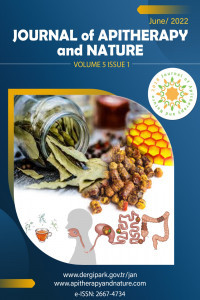Phenolic Compounds of Spain Propolis
Phenolic Compounds of Spain Propolis
Propolis, Phenolic Compounds, UPLC-MS/MS,
___
- 1. 1 Kasote, D., Suleman, T., Chen, W., Sandasi, M., Viljoen, A., van Vuuren, S. (2014) "Chemical profiling and chemometric analysis of South African propolis", Biochemical Systematics and Ecology, 55, pp. 156-163.
- 2. Dias, L. G., Pereira, A. P., Estevinho, L. M. (2012) "Comparative study of different Portuguese samples of propolis: pollinic, sensorial, physicochemical, microbiological characterization and antibacterial activity", Food and Chemical Toxicology, 50, pp. 4246-4253.
- 3. Walgrave, S. E., Warshaw, E. M., Glesne, L. A. (2005) "Allergic contact dermatitis from propolis", Dermatitis, 16(4), pp. 209-215.
- Yayın Aralığı: Yılda 2 Sayı
- Başlangıç: 2018
- Yayıncı: Oktay YILDIZ
Effect of Brazilian Propolis-containing Ointment on Genital Itching in Menopausal Women
Hiroshi MIURA, Yasuko MIURA, Yuki SHIMODA, Satoko KAGABU, Hiromitsu TSUBAKI, Yukihiro TERADA
Shankar KATEKHAYE, Hugo FEARNLEY, James FEARNLEY, Anant PARADKAR
Y. FRIÓN-HERRERA, D. GABBIA, M. CARRARA
New Insights into Tropical Propolis: Propolis from Pitcairn Island
Boryana TRUSHEVA, Kristina GEORGIEVA, Milena POPOVA, Veselina UZUNOVA, Tihomira STOYANOVA, Violeta VALCHEVA, Rumiana TZONEVA, Vassya BANKOVA
Chemical Profiling of Papua New Guinea Propolis and Assay its Antiprotozoal Activity
Samya ALENEZI, Naif Alenezi MANAL, J NATTO, Harry P. De KONING, John IGOLI, David G. WATSON
A New Approach to Propolis Extraction
Saban KESKIN, Merve KESKIN, Sevgi KOLAYLI
ARC (Apiceutical Research Centre): Exploring a New Generation of Medicines from the Beehive
Chemical Profile of Greek Arbutus unedo Honey – Biological Properties
αrgyrο ANDREOU, Ioanna CHINOU, Konstantia GRAIKOU
Phenolic Compounds of Spain Propolis
Félix ADANERO-JORGE, M Camino GARCÍA-FERNÁNDEZ, Rosa M VALENCIA-BARRERA, J. Javier SANZ-GÓMEZ
The Immune Modulatory and Anti-protozoal Effects of Different Propolis Samples
David G. WATSON, Harry de KONING, Godwin EBILOMA, John IgoLI, Weam SIHERI, Naif ALENZI, Samyah ALANAZI, Sameah ALENEZI, William HARNETT
